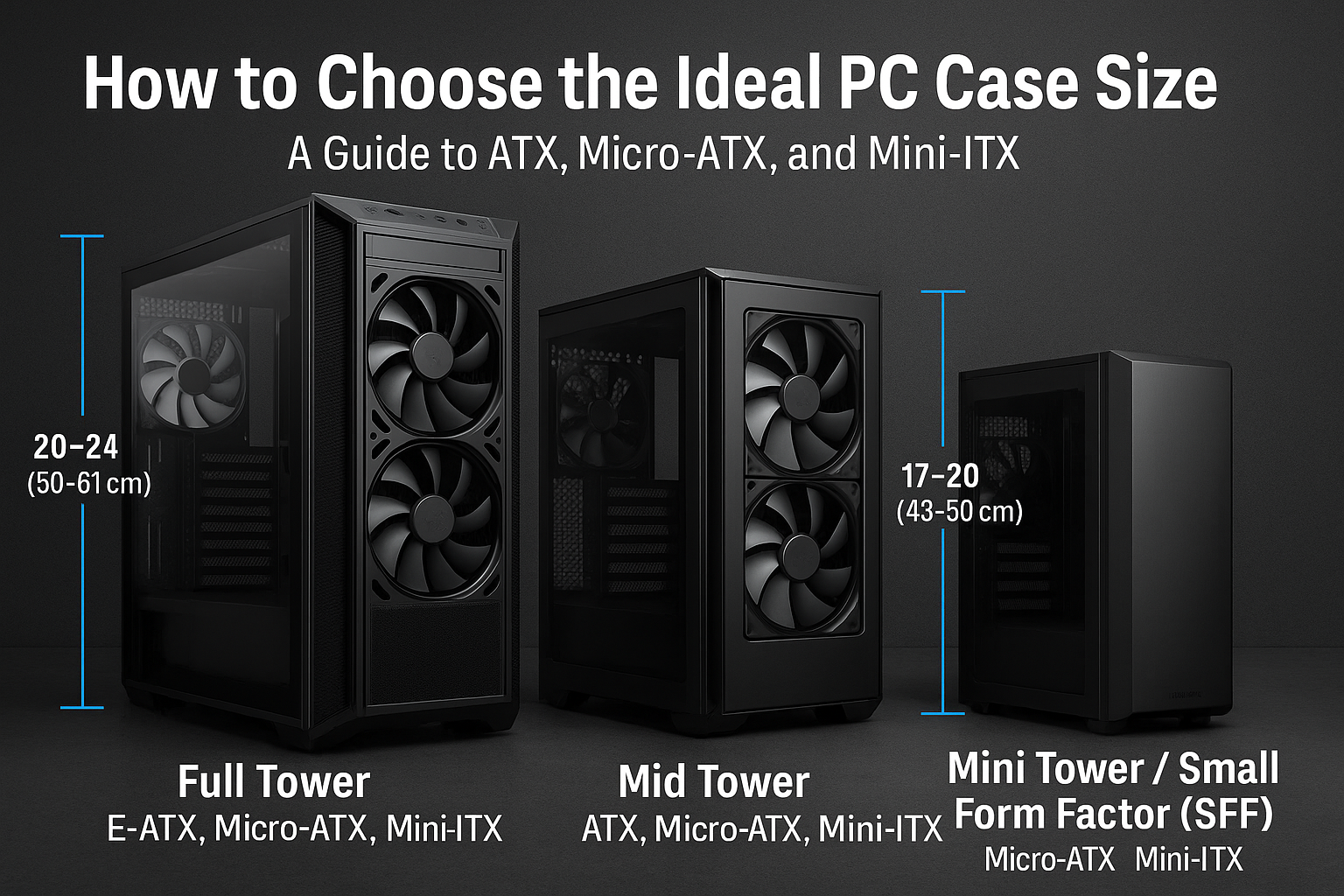Choosing the right PC case size is one of the most overlooked steps in a computer build—but it directly affects your hardware compatibility, airflow, cable management, and even future upgrade options.
Whether you’re aiming for a minimalist setup or building a high-performance beast, this guide will help you understand the differences between ATX, Micro-ATX, and Mini-ITX cases—and how to choose the right one for your needs.
Why Case Size Matters
Your case isn’t just a box. It determines:
- What parts you can install (GPU length, CPU cooler height, PSU size)
- Airflow and thermal performance
- Noise levels
- Aesthetics and desk space
- Ease of building and upgrades
Picking the wrong size can mean poor airflow, tight spaces, or even incompatibility with your motherboard.
The 3 Main Case Sizes (Form Factors)
1. Full Tower (Supports E-ATX / ATX)
- Height: 20–24 inches (50–61 cm)
- Motherboards Supported: E-ATX, ATX, Micro-ATX, Mini-ITX
- Best For: Enthusiasts, workstations, dual-GPU setups
Pros:
- Maximum space for airflow and cable management
- Room for large GPUs, radiators, and storage drives
- Easy to build and upgrade
Cons:
- Bulky and heavy
- Takes up more room on or under your desk
- Usually more expensive
2. Mid Tower (Supports ATX / Micro-ATX)
- Height: 17–20 inches (43–50 cm)
- Motherboards Supported: ATX, Micro-ATX, Mini-ITX
- Best For: Most users – gamers, creators, everyday builders
Pros:
- Great balance of space and size
- Supports most GPUs and cooling solutions
- Widely available in all price ranges
Cons:
- May not fit the largest GPUs or radiators
- Slightly cramped compared to full towers
3. Mini Tower / Small Form Factor (SFF) (Supports Micro-ATX / Mini-ITX)
- Height: 12–16 inches (30–40 cm)
- Motherboards Supported: Micro-ATX, Mini-ITX
- Best For: Compact builds, HTPCs, minimalist setups
Pros:
- Small and space-saving
- Lightweight and portable
- Sleek appearance
Cons:
- Limited airflow
- Difficult to build in (tight space)
- Restricted upgrade options
Form Factor vs Case Size: Don’t Confuse Them!
- Motherboard Form Factor refers to the size and layout of the board (ATX, mATX, ITX).
- Case Size refers to the external dimensions and what motherboard form factors it supports.
A mid tower case can support an ATX or Micro-ATX motherboard—but a Mini-ITX case will only support a Mini-ITX board.
Always check the motherboard compatibility list in the case’s spec sheet.
Case Compatibility: What to Watch For
When choosing a case, make sure it fits your components:
| Component | What to Check |
|---|---|
| Motherboard | Supported form factors (ATX, mATX, ITX) |
| GPU | Max supported length in mm |
| CPU Cooler | Max height clearance |
| Radiator | Size support (120mm, 240mm, 360mm) |
| PSU | Form factor (ATX, SFX) + length |
| Drives | Number of 2.5″ and 3.5″ bays |
Most case product pages will list this information clearly—check before buying!
Airflow vs Aesthetics: Balance Both
Larger cases tend to offer better airflow because:
- There’s more room for fans and radiators
- Cables can be better managed, improving circulation
- Heat can disperse more efficiently
Smaller cases can look cleaner or more compact but often suffer from:
- Limited fan support
- Poor airflow design
- Hotter temperatures under load
Look for:
- Mesh front panels for better intake
- Top exhaust fan mounts
- Multiple fan or AIO support
Common PC Case Types
Airflow-Focused Cases
- Prioritize ventilation
- Usually include mesh panels
- Better cooling performance
RGB/Gaming Cases
- Emphasize lighting and style
- Include tempered glass panels
- May compromise airflow for aesthetics
Minimalist or Silent Cases
- Reduce noise with sound-dampening foam
- Hide components
- Sleek design, but airflow might be limited
Open-Air or Vertical Cases
- Expose components (used in show builds)
- Great thermals but poor dust protection
Popular Case Sizes by Use Case
| Use Case | Recommended Case Size |
|---|---|
| Gaming PC (mid/high-end) | Mid tower |
| Streaming + gaming setup | Full tower or mid tower |
| Compact or HTPC setup | Mini-ITX or small form factor |
| Budget build | Mid or mini tower (Micro-ATX) |
| Heavy multitasking / workstation | Full tower |
Cable Management Considerations
Larger cases offer:
- More space behind the motherboard tray
- Velcro straps and cable channels
- Better airflow due to tidy layout
Smaller cases require:
- Shorter cables or custom cables
- Precision and patience during building
For beginners, a mid tower case with cable routing channels is highly recommended.
Don’t Forget Front I/O and Expansion
Check the front/top panel for:
- USB 3.0 / USB-C ports
- Audio jacks
- Reset button
- Power button placement
Also consider:
- PCIe expansion slot count
- Drive mounting flexibility
- Vertical GPU support (optional)
Final Thoughts: Match Your Case to Your Needs
Choosing the right PC case size isn’t just about looks—it impacts your build experience, thermal performance, and upgrade potential.
- Go mid tower for maximum compatibility and ease.
- Choose mini-ITX or Micro-ATX if you want a compact or minimalist build.
- Opt for full tower if you’re building a high-end or dual-GPU workstation.
Measure your space, plan your components, and invest in a case that not only fits—but also protects, cools, and complements your PC.
